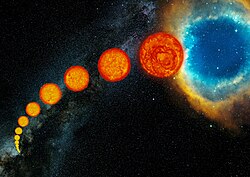Stellar evolution
Stellar evolution is the study of how a star changes over time. Stars can change very much between when they are first created and when they run out of energy. Because stars can produce light and heat for millions or billions of years, scientists study stellar evolution by studying many different stars in different stages of their life.
The stages in a star's life are: protostar, main-sequence star, red giant and compact star: either white dwarf followed by black dwarf, neutron star or black hole.

How a star is born
A star starts its life as a cloud of dust and gas called a nebula. This is pulled together by gravity which causes it to heat up. It also starts to spin and to look like a ball. When it gets hot enough, it starts to release energy through nuclear fusion, changing hydrogen to helium. This makes it shine very brightly and become what astronomers think of as a main-sequence star. It may stay a main-sequence star, looking about the same, for billions of years.

The details of a main-sequence star are based on its mass. The mass is often measured in terms of the Sun's mass, or a solar mass, equal to 1.99 x 1030 kilograms.
- If a star is less than 0.65 solar masses, it is a red dwarf. Red dwarfs change very slowly that none of them have entered "old age". They are still very young and will only change after a time much longer than the age of the universe.[1]
- If a star is between 0.65 and 1.4 solar masses, it is a yellow dwarf like our Sun or the two large Alpha Centauri stars.[2] These tend to have "live" between 1 and 50 billion years.
- If a star is over 1.4 solar masses, it is a white or blue main sequence star (sometimes called a blue dwarf). These change even more slowly than smaller stars but are very large and bright.
How a star enters old age
Sooner or later, almost all of the hydrogen at the center has changed to helium. This causes the nuclear reaction in the middle of the star to stop and the center will start to get smaller due to the star's gravity. The layer of the star just outside the center will begin to change hydrogen to helium, releasing energy.
A star between 0.25 and 8 solar masses will get much, much bigger. The star will make much more light, sometimes as much as ten thousand times as much as it did at first. Since the surface of the star will get bigger, this energy will be spread out over a much larger area. Because of this, the temperature of the surface will go down and the color will change to red or orange. It will become a red giant. It can swallow up any planets that orbit around it.
A star between 8 and 40 solar masses (typically a massive blue main-sequence star) does not become a mere red giant. It expands even larger to become a supergiant. Sometimes the outer layer temperature does not go down. If the temperature goes down, we have a red supergiant. If the temperature does not go down we have a blue supergiant. Red supergiants are larger, cooler, and not as bright as blue supergiants, but supergiants can often change between blue and red. As they change they often go through an unstable yellow phase, resulting in Cepheid variables (yellow supergiants).
Stars above 40 solar masses do not cool down and become red supergiants. They stay as blue supergiants before "dying" in a few million years.[3]
How a star dies
Later, the red giant that was left over from a star between 0.65 and 8 solar masses, like our Sun, stops burning. A cloud of gas is given off and a smaller star called a white dwarf is left behind. White dwarfs are the size of Earth or Venus. After a really long time, the white dwarf cools down into a black dwarf.
But, when a bigger red or blue supergiant (between 8 and 20 solar masses) explodes, the explosion is a lot larger and is called a supernova. Instead of a white dwarf, it leaves behind a much smaller, much denser ball called a neutron star. A neutron star is created because the force of gravity is so strong that the atoms left behind would not have any electrons orbiting the nucleus of the atoms. A teaspoon of that matter might weigh as much as the entire Earth.
A much bigger supergiant (called a hypergiant and more than 20 solar masses) explodes in a hypernova. This leaves behind a black hole. A black hole is created because gravity is so strong that even the protons and neutrons collapse in on themselves. Even light can no longer escape a black hole. Since there is nothing we know of stronger than the force that holds atomic nuclei (the plural of 'nucleus') together, some physicists think that a black hole collapses all the way down to a mathematical point called a singularity.
Stellar Evolution Media
Artist's depiction of the life cycle of a Sun-like star, starting as a main-sequence star at lower left then expanding through the subgiant and giant phases, until its outer envelope is expelled to form a planetary nebula at upper right
The Cat's Eye Nebula, a planetary nebula formed by the death of a star with about the same mass as the Sun
Reconstructed image of Antares, a red supergiant
References
- ↑ Adams, F. C.; Bodenheimer, P.; Laughlin, G. (December 2005). "M dwarfs: planet formation and long term evolution". Astronomische Nachrichten. 326 (10): 913–919. doi:10.1002/asna.200510440. ISSN 0004-6337.
- ↑ Habets, G. M. H. J.; Heintze, J. R. W. (1981-11-01). "Empirical bolometric corrections for the main-sequence". Astronomy and Astrophysics Supplement Series. 46: 193–237. Bibcode:1981A&AS...46..193H. ISSN 0365-0138.
- ↑ Vanbeveren, D.; De Loore, C.; Van Rensbergen, W. (1998-01-01). "Massive stars". Astronomy and Astrophysics Review. 9 (1–2): 63–152. Bibcode:1998A&ARv...9...63V. doi:10.1007/s001590050015. ISSN 0935-4956. S2CID 189933559.








